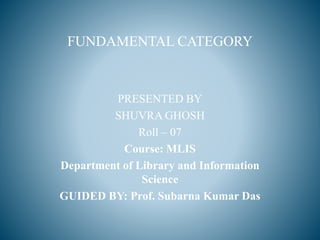Ranganathan introduced the concept of fundamental categories in library classification. There are five fundamental categories: Personality, Matter, Energy, Space, and Time. These categories are used to group concepts and determine the order of facets in compound subject classifications. Personality indicates who, Matter indicates what, Energy indicates how, Space indicates where, and Time indicates when. The categories are ordered from most concrete to least concrete as Personality, Matter, Energy, Space, Time. This sequence forms the basis of Colon Classification and provides a framework for systematically organizing information.









![FUNDAMENTAL CATEGORIES
• There are five fundamental category
PERSONALITY [P]
MATTER [M]
ENERGY [E]
SPACE [S]
TIME [T]
PERSONALITY [P] WHO (Comma) ,
MATTER [M] WHAT (Semi Colon) ;
ENERGY [E] HOW (Colon) :
SPACE [S] WHERE (Dot) .
TIME [T] WHEN (Inverted Comma) ‘](https://image.slidesharecdn.com/presentation1fundamentalcategory-190410234140/85/Fundamental-Category-10-320.jpg)
![EXAMPLE
Classification of books in Indian national library during 1991.
1991 [T]
India [S]
Classification [E]
Books [M]
National library [P]](https://image.slidesharecdn.com/presentation1fundamentalcategory-190410234140/85/Fundamental-Category-11-320.jpg)


![Personality [P]
The Personality facet indicates the core point of the subject at
hand.
Characteristics of main class.
Comma (,) is Connecting symbol for personality.
Use of personality in different main classes according to their
facet formula and specific rules.](https://image.slidesharecdn.com/presentation1fundamentalcategory-190410234140/85/Fundamental-Category-14-320.jpg)
![Use of Personality
Personality as a Space [S]
Ex. Indian history V44
British law Z56
Personality as a time [T]
Ex. Biography of Dr. Ranganathan 2wM92
Personality as a Language
Ex. English Language P111
Hindi Literature O152](https://image.slidesharecdn.com/presentation1fundamentalcategory-190410234140/85/Fundamental-Category-15-320.jpg)
![Matter [M]
The Matter facet typically deals with some concrete object
typically inanimate.
Matter are basically material, property and things.
Semicolon (;) is the connecting symbol for the matter.
Use of matter only in few main classes such as Library
science, Biology, Fine arts etc.](https://image.slidesharecdn.com/presentation1fundamentalcategory-190410234140/85/Fundamental-Category-16-320.jpg)



![Space
Space facet indicates to geographical area such as nation, state,
city, continent, country, village.
Space isolate gave on the page no. For different areas.
Use of space in few main class for [P] such as History, Law.
Dot (.) is Connecting symbol for space.](https://image.slidesharecdn.com/presentation1fundamentalcategory-190410234140/85/Fundamental-Category-20-320.jpg)





